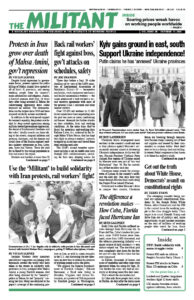Three days before a Sept. 29 strike deadline set by vote of the 6,600 members of International Association of Machinists District 19 — locomotive machinists, track equipment mechanics and facility maintenance workers — the union announced it had reached a second tentative agreement with most of the national Class 1 railroads and other smaller carriers.
Over 115,000 rail workers in 12 different unions have been negotiating over the past two years or more, confronting rail bosses’ demands for further attacks on their schedules, lives and working conditions. At the same time, they’ve faced the notorious anti-working-class Railway Labor Act, enforced by the Joseph Biden White House, that has kept their fight to advance workers’ interests wrapped up in red tape and barred them from striking until now.
The IAM’s second tentative agreement includes a cap on health care costs through 2025; reimbursements, including for their own sleeping rooms for away-from-home assignments and per diem for travel expenses; and yet more negotiations over the bosses’ call for forced overtime.
IAM members still need to vote on these proposals. Their first agreement was rejected Sept. 14 by 75%.
Members of the International Brotherhood of Electrical Workers, 4,000 strong, voted up an agreement Sept. 28, joining 13,000 members of two other rail unions — the Transportation Communications Union and Brotherhood of Railway Carmen — with ratified contracts.
Many conductors and engineers, members of the two largest rail unions — the Transportation Division of the Sheet Metal, Air, Rail and Transportation Workers (SMART-TD) and Brotherhood of Locomotive Engineers and Trainmen, combined totaling over 60,000 workers — remain dissatisfied and angry about the tentative agreements they’ve been sent.
Ratification votes have been set for mid-November, after the upcoming midterm congressional elections. This means Biden and the Democrats won’t face the possibility of a strike or boss lockout and the disruptions this might cause going into the voting.
Central questions outstanding
The key questions of unsafe working conditions, torturous schedules and punitive attendance policies are not addressed in the tentative proposal. Under these conditions, hundreds of workers quit this year. And the rail bosses are demanding further reductions in crew size down to one!
“As far as the pay raise goes, the vast majority of us are more than OK with it. The main issue with the tentative agreement comes from the ‘quality-of-life issues,’” Travis Zuluaga, a conductor and engineer and member of Brotherhood of Locomotive Engineers and Trainmen in the Albany, New York, area, told the Militant.
All 12 rail unions have similar tentative agreements on monetary issues brokered by Biden’s Presidential Emergency Board, including offers of a 24% compounded general wage increase, a $5,000 bonus, and retroactive pay, payable within 60 days of ratification.
Zuluaga said the money issues are not at the top of their concerns. “We just want to be able to be a natural human without being penalized. It is bad enough that we miss birthdays, holidays, graduations, weddings, funerals and any other special occasion that most people are able to get time off for,” he said. “We are literally being told that we are not allowed to be sick without being penalized for it. The tentative agreement would give us three doctor visits a year, and they have to be scheduled on a day that is convenient for the company at least 30 days in advance. It’s laughable.”
“Some people argue, ‘This is the best we’re going to get, so we may as well take it,’” Joe Allen, a SMART-TD conductor in Albany, said. “Others see through what the railroads are offering. They say, ‘The money’s not enough and there is no time off work, so I think this is the best opportunity to fight them.’
“And some people say, ‘What do other unions have to do with me?’ But this has everything to do with you. This is across the country. We should be going public, we will get support. So, when the politicians tell us, ‘You’re screwing up the country,’ we’ll say, ‘No, you’re screwing it up.’”
Deadly schedules
Another problem the proposal doesn’t address is having a regular job and schedule. “I hate the automatic bid system. This is what engineers where I work live under, a weekly bid system,” said engineer and BLET member Robin Smith from Harrisburg, Pennsylvania. “It means engineers don’t know until Thursday at noon what job we’ll work starting that coming Saturday. That’s only 36 hour notice.
“And if you’re on the extra board your group can change weekly, which changes your rest days,” she said. “You thought that finally after six weeks you will have the weekend off only to find out 36 hours ahead of time that your rest days are now Monday and Tuesday!”
“Being able to get to a doctor’s appointment, scheduled a month in advance, is a joke. What if the doctor says you need to have a test and need to return the following week for a follow-up?” she said. “This happened to me last month. Women usually need to visit the doctor more than three times a year.
“And one extra personal day, which needs to be scheduled in November during vacation bidding! You don’t know what job you will be on week to week, how can you schedule that far in advance?”
These conditions — uncertain schedules, long hours all the time away from home, demands for even smaller crews and more — are a recipe for disaster. They exhaust workers and deny them and their families the time to have a life together. Accidents are a constant concern.
Fifteen rail cars, including tankers full of gasoline that spilled out, derailed on a BNSF train near Bridger, Montana, Sept. 30. Luckily, crew members, people in the area, livestock and nearby rivers were reported to be unharmed.
But three rail workers have been killed on the job in the past six weeks.
Thousands of SMART-TD rail workers were angered when Jeremy Ferguson, their union president, reported Sept. 30 that the carriers responded in negotiations “with nothing more than ‘labor doesn’t contribute to profits.’”
Workers printed up union T-shirts with that quote and wore them at Nebraska Labor Day festivities in Omaha and at union meetings.
Crew size
Conductor Brian Raleigh started working for Norfolk Southern Railway in 2004. Working out of Decatur, Illinois, he got very ill on the job in January 2022. His engineer, Travis Pierce, notified the dispatcher, who called an ambulance. It turned out Raleigh had coronavirus and was burning up with fever, reported FreightWaves.
Norfolk Southern, like most Class 1 railroads, is pushing to cut crews from two to one person, who would have to do the work of both conductor and engineer.
“If it would have been just him on there, who knows how long it would have been until [the ambulances] got there?” Pierce said. “If it was just me, what would have happened? Would I have died?”
Norfolk Southern bosses declined to comment.
Exhaustion is already slamming his co-workers, Raleigh said. “These engineers are so worn out, they’re going to fall asleep at the wheel if they’re all by themselves.”
“It’s not just about saving my partner,” he said. “It’s about saving my community.”
“I understand the desire amongst many of you to strike. I know the contempt the carriers treat you with at work and have faced it in negotiations,” Ferguson told SMART-TD members in his Sept. 30 letter.
That acknowledges the years of anger and frustration by tens of thousands of working union rail workers. It also recognizes the potential power of the rail unions in withholding labor power.
If even one of the unions does reject their deal, they all agree they’ll go on strike. But it wouldn’t be until Dec. 9, because union officials have agreed to delay any walkout until then.
Stay tuned.


